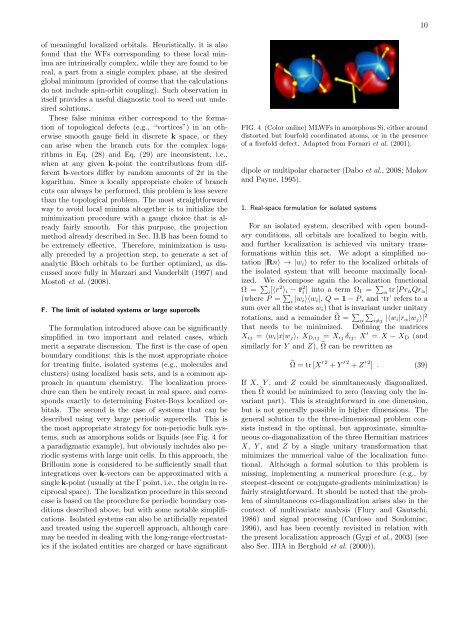Maximally localized Wannier functions: Theory and applications
Maximally localized Wannier functions: Theory and applications
Maximally localized Wannier functions: Theory and applications
You also want an ePaper? Increase the reach of your titles
YUMPU automatically turns print PDFs into web optimized ePapers that Google loves.
10<br />
of meaningful <strong>localized</strong> orbitals. Heuristically, it is also<br />
found that the WFs corresponding to these local minima<br />
are intrinsically complex, while they are found to be<br />
real, a part from a single complex phase, at the desired<br />
global minimum (provided of course that the calculations<br />
do not include spin-orbit coupling). Such observation in<br />
itself provides a useful diagnostic tool to weed out undesired<br />
solutions.<br />
These false minima either correspond to the formation<br />
of topological defects (e.g., “vortices”) in an otherwise<br />
smooth gauge field in discrete k space, or they<br />
can arise when the branch cuts for the complex logarithms<br />
in Eq. (28) <strong>and</strong> Eq. (29) are inconsistent, i.e.,<br />
when at any given k-point the contributions from different<br />
b-vectors differ by r<strong>and</strong>om amounts of 2π in the<br />
logarithm. Since a locally appropriate choice of branch<br />
cuts can always be performed, this problem is less severe<br />
than the topological problem. The most straightforward<br />
way to avoid local minima altogether is to initialize the<br />
minimization procedure with a gauge choice that is already<br />
fairly smooth. For this purpose, the projection<br />
method already described in Sec. II.B has been found to<br />
be extremely effective. Therefore, minimization is usually<br />
preceded by a projection step, to generate a set of<br />
analytic Bloch orbitals to be further optimized, as discussed<br />
more fully in Marzari <strong>and</strong> V<strong>and</strong>erbilt (1997) <strong>and</strong><br />
Mostofi et al. (2008).<br />
F. The limit of isolated systems or large supercells<br />
The formulation introduced above can be significantly<br />
simplified in two important <strong>and</strong> related cases, which<br />
merit a separate discussion. The first is the case of open<br />
boundary conditions: this is the most appropriate choice<br />
for treating finite, isolated systems (e.g., molecules <strong>and</strong><br />
clusters) using <strong>localized</strong> basis sets, <strong>and</strong> is a common approach<br />
in quantum chemistry. The localization procedure<br />
can then be entirely recast in real space, <strong>and</strong> corresponds<br />
exactly to determining Foster-Boys <strong>localized</strong> orbitals.<br />
The second is the case of systems that can be<br />
described using very large periodic supercells. This is<br />
the most appropriate strategy for non-periodic bulk systems,<br />
such as amorphous solids or liquids (see Fig. 4 for<br />
a paradigmatic example), but obviously includes also periodic<br />
systems with large unit cells. In this approach, the<br />
Brillouin zone is considered to be sufficiently small that<br />
integrations over k-vectors can be approximated with a<br />
single k-point (usually at the Γ point, i.e., the origin in reciprocal<br />
space). The localization procedure in this second<br />
case is based on the procedure for periodic boundary conditions<br />
described above, but with some notable simplifications.<br />
Isolated systems can also be artificially repeated<br />
<strong>and</strong> treated using the supercell approach, although care<br />
may be needed in dealing with the long-range electrostatics<br />
if the isolated entities are charged or have significant<br />
FIG. 4 (Color online) MLWFs in amorphous Si, either around<br />
distorted but fourfold coordinated atoms, or in the presence<br />
of a fivefold defect. Adapted from Fornari et al. (2001).<br />
dipole or multipolar character (Dabo et al., 2008; Makov<br />
<strong>and</strong> Payne, 1995).<br />
1. Real-space formulation for isolated systems<br />
For an isolated system, described with open boundary<br />
conditions, all orbitals are <strong>localized</strong> to begin with,<br />
<strong>and</strong> further localization is achieved via unitary transformations<br />
within this set. We adopt a simplified notation<br />
|Rn⟩ → |w i ⟩ to refer to the <strong>localized</strong> orbitals of<br />
the isolated system that will become maximally <strong>localized</strong>.<br />
We decompose again the localization functional<br />
Ω = ∑ i [⟨r2 ⟩ i − ¯r 2 i ] into a term Ω I = ∑ α tr [P r αQr α ]<br />
(where P = ∑ i |w i⟩⟨w i |, Q = 1 − P , <strong>and</strong> ‘tr’ refers to a<br />
sum over all the states w i ) that is invariant under unitary<br />
rotations, <strong>and</strong> a remainder ˜Ω = ∑ α<br />
∑i≠j |⟨w i|r α |w j ⟩| 2<br />
that needs to be minimized. Defining the matrices<br />
X ij = ⟨w i |x|w j ⟩, X D,ij = X ij δ ij , X ′ = X − X D (<strong>and</strong><br />
similarly for Y <strong>and</strong> Z), ˜Ω can be rewritten as<br />
˜Ω = tr [X ′ 2 + Y ′ 2 + Z ′ 2 ] . (39)<br />
If X, Y , <strong>and</strong> Z could be simultaneously diagonalized,<br />
then ˜Ω would be minimized to zero (leaving only the invariant<br />
part). This is straightforward in one dimension,<br />
but is not generally possible in higher dimensions. The<br />
general solution to the three-dimensional problem consists<br />
instead in the optimal, but approximate, simultaneous<br />
co-diagonalization of the three Hermitian matrices<br />
X, Y , <strong>and</strong> Z by a single unitary transformation that<br />
minimizes the numerical value of the localization functional.<br />
Although a formal solution to this problem is<br />
missing, implementing a numerical procedure (e.g., by<br />
steepest-descent or conjugate-gradients minimization) is<br />
fairly straightforward. It should be noted that the problem<br />
of simultaneous co-diagonalization arises also in the<br />
context of multivariate analysis (Flury <strong>and</strong> Gautschi,<br />
1986) <strong>and</strong> signal processing (Cardoso <strong>and</strong> Soulomiac,<br />
1996), <strong>and</strong> has been recently revisited in relation with<br />
the present localization approach (Gygi et al., 2003) (see<br />
also Sec. IIIA in Berghold et al. (2000)).













